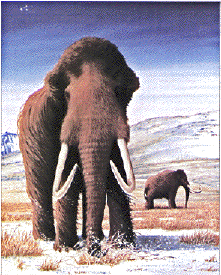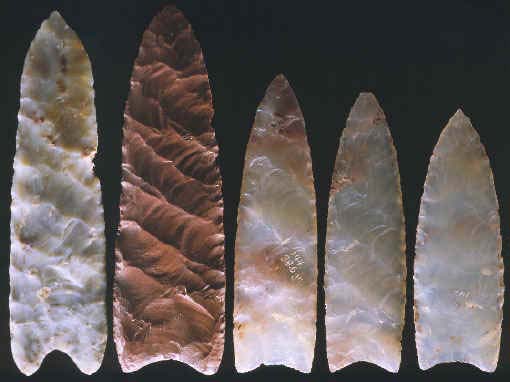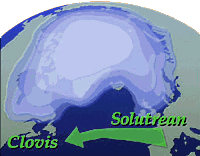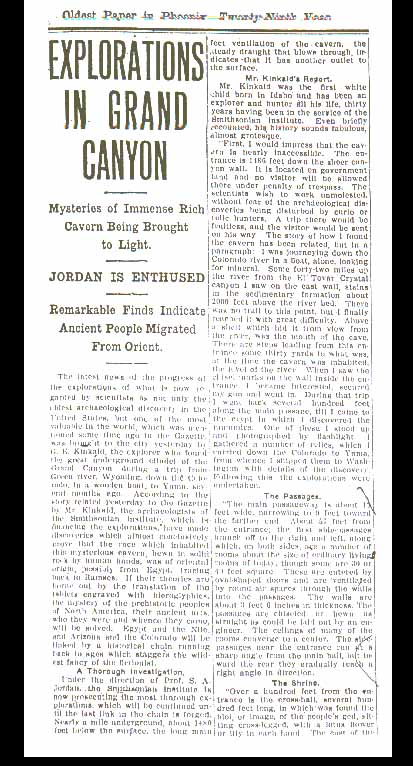Clovis People
The Clovis culture is a prehistoric Native American culture that first appears in the archaeological record of North America around 13,500 years ago, at the end of the last ice age.
The culture is named for artifacts found near Clovis, New Mexico, where the first evidence of this tool complex was excavated in 1932. Earlier evidence included a mammoth skeleton with a spear-point in its ribs, found by a cowboy in 1926 near Folsom, New Mexico. Clovis sites have since been identified throughout all of the contiguous United States, as well as Mexico and Central America.
The Clovis people, also known as Paleo-Indians, are generally regarded as the the first human inhabitants of the New World, and ancestors of all the indigenous cultures of North and South America. However, this view has been recently contested by various archaeological finds which are claimed to be much older.
There are a number of controversial sites vying for the position of the earliest site in the region. The best evidence, however, suggests that a society of hunters and gatherers known as Clovis People were the first to settle in the Southwest, probably sometime before 9,500 B.C. The Clovis People were so named after the New Mexico town, site of the first discovery in 1932, near Clovis, N.M.
Since the mid 20th century, the standard theory among archaelogists has been that the Clovis people were the first inhabitants of the Americas. The primary support of the theory was that no solid evidence of pre-Clovis human inhabitation has been found. According to the standard accepted theory, the Clovis people crossed the Beringia land bridge over the Bering Strait from Siberia to Alaska during the period of lowered sea levels during the ice age, then made their way southward through an ice-free corridor east of the Rocky Mountains in present-day western Canada as the glaciers retreated.
The culture lasted for about a half a millennium, from about 11,200 to 10,900 years ago. People of the Clovis culture were successful, efficient big-game hunters and foragers. Judging from sites on the North American Great Plains, the Clovis people were skilled hunters of huge animals, especially Ice Age mammoths and mastodons.
It is generally accepted that Clovis people hunted mammoth: sites abound where Clovis points are found mixed in with mammoth remains. Whether they drove the mammoth to extinction via overhunting them - the so-called Pleistocene overkill hypothesis - is still an open, and controversial, question, keeping in mind that Archaeology is purely a theoretical endeavor.

A single animal could provide meat for weeks on end, and if dried, for much of the winter, also. Not that the people used all the meat they butchered. Bison carcasses were more heavily utilized and less was left at the kill sites. Presumably, the hides, tusks, bones, and pelts were used to make household possessions, subsistence tools, for shelter, even clothing.

Clovis tool kits were highly effective, lightweight, and portable, as befits people who were constantly on the move. Their stone technology was based on precious, fine-grained rock that came from widely separated outcrops, ones that were exploited for thousands of years by later people. Their most famous, celebrated, and distinctive part of their toolkit were their fluted projectile points.
A hallmark of Clovis culture is the use of a distinctively-shaped fluted rock spear point, known as the Clovis point. The Clovis point is distinctively bifacial and fluted on both sides, a feature that possibly allowed the point to be mounted onto a spear in a way so that the point would snap off on impact. Archaeologists do not agree on whether the widespread presence of these artifacts indicates the proliferation of a single people, or the adoption of a superior technology by non-Clovis people.
The typical Clovis point is leaf shaped, with parallel or slightly convex sides and a concave base. The edges of the basal portions are ground somewhat, probably to prevent the edge from severing the hafting cord. Clovis points range in length from 1 1/2 to 5 inches (4 to 13 centimetres) and are heavy and fluted, though the fluting rarely exceeds half the length. Some eastern variants of Clovis, called Ohio, Cumberland, or Suwannee, depending on their origin, are somewhat fish tailed and also narrower relative to length.
Exactly how these points were hafted is unknown, but the men probably carried a series of them mounted in wooden or bone foreshafts that worked loose from the spear shaft once the head was buried in its quarry. The Clovis people became successful hunters, often killing mammoth, mastodons, huge bison, horses and camels throughout the great plains of North America and into northern Mexico.
Also associated with Clovis are such implements as bone tools, hammerstones, scrapers, and unfluted projectile points. Besides projectile points, the Clovis people used bifacially trimmed points and other woodworking and butchering artifacts, as well as flakes used simply as sharp-edged, convenient tools in their struck-off form.
Botany
The Clovis People were also botanists well-versed in the use of plants for food and equipment. They were geologistswith a keen ability to seek out the best sources of New World flint for their finely crafted points and tools, and of ochre for use as a red pigment.
Settlements
Clovis settled successfully into a broad range of environments. And after half a century of research, questions and disagreements still surround this short-lived, but extremely widespread North American culture.
Origins - History
Once thought to span thousands of years, the Clovis era is now dated to a few hundred, roughly from 11,400 to 10,900 radiocarbon years ago (13,325 - 12,975 cal BP)
In many ways, the Clovis people seem to appear by magic on the North American continent. The assumption has been that their ancestors moved south from Alaska, pursuing their favorite prey, the mammoth. However, there are no Clovis sites in either Alaska or Canada; likewise, there are no technological antecedants for Clovis anywhere in the Americas nor are their any technological antecedants in northeast Asia, extreme eastern Asia, or anywhere in Asia. So from where did the Clovis people come - or at least, from where did their technology of producing finely crafted, fluted spear points, come?
Some scientists have speculated that the ancestors of the Clovis people perfected their distinctive toolkits and fluting techniques while in route, via the (in)famous "ice-free corridor", from Alaska to the great plains of North America.
Other scientists have suggested that the ancestors of the Clovis people lived South of North America since there are isolated hints of human settlement earlier than 11,500 years ago (the earliest time Clovis appears in North America), at places like Monte Verde in southern Chile and Pedra Furada in Brazil. Alternately, there are a few sites in North America which pre-date Clovis, such as Meadowcroft Rockshelter, in western Pennsylvannia, and Pendejo Cave in New Mexico, and it may be that these sites represent not only a Pre-Clovis population, but one technologically ancestral to Clovis.
Currently several scientists have suggested that the technological ancestors of Clovis lie in Europe, specifically on the Iberian peninsula and France, with the so-called Solutrean culture.

According to archaeologist Dr. Bruce Bradley, both the Solutreans and the Clovis folks made beveled, crosshatched bone rods, idiosyncratic spear points of mammoth ivory, and triangular stone scrapers.
And while independent invention could account for these similarities (i.e., finding the same solutions to the same questions), the oldest Clovis tools are not on the Great Plains, or in the Great Basin or Southwest of the U.S. - where they should be if the Clovis people trickled in from Siberia and then fanned out across the continent - but rather they are found in the eastern and southeastern regions of the U.S. It's possible that Ice Age Europeans may have crossed into North America by boats, hugging the edges of the great ice sheets that stretched from Greenland westward to what is now upstate New York.
Around 10,500 years ago, Clovis abruptly vanish from the archaeological record, replaced by a myriad of different local hunter-gatherer cultures. Why this happened no one knows but their disappearnce coincides with the mass extinction of Ice Age big-game animals, leading to speculation that Clovis people either overhunted these mammals and drove them into extinction or over-hunting eliminated a "keystone species" (usually the mammoths or mastodon) and this led to environmental collapse and a more general extinction.
Another theory about the Clovis people is that these people caused the extinction in North America at the end of the Pleistocene. Researchers who support this view generally favor one of two explanations. The first is that human over-hunting directly caused the extinction. The second is that over-hunting eliminated a "keystone species" (usually the mammoths or mastodon) and this led to environmental collapse and a more general extinction.

Replies
Peace